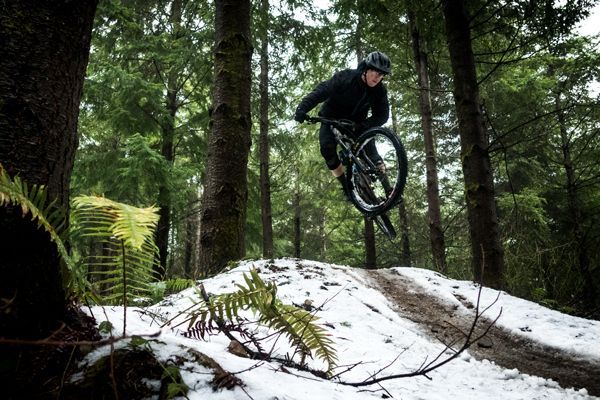Ride Don't Slide! Tips For Keeping Trails in Great Shape Through Winter
--
Winter riding can provide some great opportunities for getting out– just make sure you aren’t creating more work for your trail builders when they dry out in the spring.
Understanding how and when the “Freeze-Thaw” process works is key to a successful ride and reduction of trail damage.
Riding the Cycle of Freeze/Thaw
With the moderate winter temps and weather we experience in the Northwest, we're lucky to be able to ride year-round. However, this can be a benefit and a curse (to the trail crew) if you aren’t careful. By considering the weather before riding that ribbon of single track this time of year you can reduce your impact and improve your ride. You've probably heard or read someone mention the “freeze-thaw cycle”. Here is what you need to know:
When it gets cold outside moisture in the soil begins to freeze. The water in the soil expands as it freezes which makes it vulnerable when thawing. You can see this when you look at the ground and crystals of ice have formed and spread across the ground. When it's frozen it is generally pretty durable and rideable. Once it’s frozen, the trail tread can be about as resilient as it is in the summer, even more. You can ride it and not leave any mark and sometimes feel a better grip than you may otherwise feel.
When it starts warming up, that frozen water that has expanded and separated the dirt particles causes the trail tread to lose its resilience. When you see a section of trail that starts to glisten or looks slimy, you are likely seeing a freeze-thaw cycle in action. These telltale signs mean it’s time to get off that trail.
Open areas freeze harder than forested areas or places with more canopy. A few users through an area like this may not do lasting damage, but more users will. Sometimes this damage will self-correct and other times it requires trail maintenance to fix. Exiting the tread or going around the spots only creates more damage– better to go straight through rather than damage the surrounding terrain.
Soil types will dictate the severity of damage the freeze-thaw effect can create. High clay content soils are harder to fix than loamier trails with more organic matter in them. Clay soils become like peanut butter in the thaw and turn to concrete when dry due to the amount of water they hold. Trails with a high mineral soil content (more rock) will be less affected.
What about riding in the snow?
Get a fat bike! Really, anything more than a few inches is Fat Bike Territory, but if it’s only a dusting of snow you can ride any bike with the right tires and appropriate weather conditions. Snow acts as an insulator on the tread. If the ground was frozen before the snow fell, then it will likely stay that way until the snow melts. This will produce a firm tread and all you’ll really need to worry about is the snow being too slippery.
Unfortunately, in Western Washington, the ground doesn’t typically have a chance to freeze first and the result is typically snow over a wet, soft ground. A dip in temperature and layer of snow on top will keep it that way—wet, soft, and vulnerable. Time to stay off!
When there's snow on the trail your line choices are typically reduced and you’ll tend to follow a single line down the path of least resistance and thus, create a snow rut down the tread. When things warm up, this snow rut melts first and water will run down the trail instead of sheeting across it as the surrounding snow acts as a barrier.
It's important to keep in mind that all the work done designing and building a trail can be compromised as a result of not paying attention to the freeze/thaw cycle when you ride. You can reduce impact to the trail during these times by following some of these basic guidelines:
• Watch the weather forecast. Have there been temperature swings above and below freezing? Plan your ride accordingly.
• Ride early, finish early. It’s generally colder in the morning before the sun hits the trails.
• Switch up your ride locations. Look for the low elevation, well-drained riding areas that are typically well below the freezing level with soil types that favor winter riding.
• Change up your standard route. Places like Tiger and Raging have lower elevation options that were designed with winter riding specifically in mind.
• Check ride reports, or one of the webcams for trail conditions at your desired location.
• Be prepared to not ride. Just because you’re there doesn’t mean you have to ride it. If the conditions are damaging the trail, you’ll be happier in the spring when less work is needed to repair your favorite trail.
The bottom line is that Evergreen and hundreds of your fellow members work hard to keep trails all over Washington State riding well every year. And you can help by riding smart during the freeze/thaw.
Ride On!
-
Nick Newhall
Evergreen Volunteer Trail Builder
Lead Builder of EBAD at Tiger Mountain


